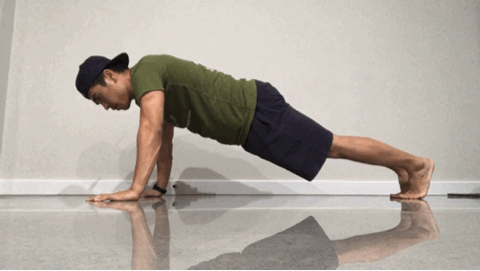
The best online fitness resource you'll ever need. We filter out the BS to ensure you meet your health and fitness goals!

The best online fitness resource you'll ever need. We filter out the BS to ensure you meet your health and fitness goals!

By definition, muscular endurance is the ability of a group of muscles to sustain repeated contractions against a specific resistance over a period of time.
But this component of fitness is often mistaken for muscular strength and power, which we’ll cover in another post. For example, if you’re in the gym lifting 50 kilos over your head, and you gas out at 5-6 repetitions, this is considered muscular strength, not endurance.
Whereas if you’re lifting the same weight for 20 – 25 repetitions, you’re entering into the realm of muscular endurance This is because you’re exerting that effort over a prolonged period of time.
Now, because the fitness industry is so subjective in its opinions and views, other people may have different opinions on what’s considered the “correct” number of reps for endurance work. But the bottom line is if you’re lifting something for a sustained period of time, you’re improving muscular endurance. If it’s a maximal effort which lasts less than 10 seconds, it’s considered strength training.
In today’s post, I’m going to share with you how to improve your muscular endurance exponentially. And then i’m going to show you how you can test it on a regular basis to ensure you’re hitting your training goals.
Before you can understand how to improve muscular endurance, you need to get your head around the idea that it comes in different forms. So yeah, it’s not just how much weight your muscles can lift for a sustained effort over time.
Yes, with strength training it refers to the number of repetitions of a single exercise you can do without needing to stop and rest. Some examples of this might include how many deadlifts, squats or shoulders presses you can perform with a light-moderate weight, without breaking form. In other words, as soon as you start arching your spine or using your legs to “chuck” the weight above your head, you’ve reached maximum output (without trying to sound too nerdy).
But you also have to factor in cardiorespiratory endurance too. This refers to the ability of the body to continue performing a cardiovascular activity like running or swimming, over a prolonged period of time.
It refers specifically to the energy systems of the body (i.e. your heart and lungs), and the smaller muscles and capillaries in the body that are able to sustain long periods of exercise, like running a marathon, or taking part in a triathlon (some people like to do crazy things).
The American College of Sports Medicine recommends muscular endurance testing, as well as muscular strength testing when you start a program of strength training.
This will allow you to set the correct intensity and resistance loads for your training program. One so you can prevent injury, and two so you’re not venturing into other components of fitness like strength and power training.
Today I’m going to recommend four different tests to complete so you can get an accurate idea of just how fit you are.
The tests I’m going to suggest are:
To perform this test, you’ll be performing as many push ups as you possibly can for one minute.
To perform the press up correctly there are several steps you should observe:
This is a test of how many squats you can perform in one minute. As such, it is very similar to the push up test, only it’s testing lower body muscular endurance.
Again, you’re going to be using the same parameters as the other two tests, 1 minute to perform as many sit ups as you can. Here’s how you do it effectively:
This one still gives me the heebie jeebies quite frankly, with memories of doing it as a fitness test at school.
Nonetheless, this still remains an excellent way to test your cardiorespiratory fitness. All you need is something to mark out 20 meters and a free bleep test app (hop on the app store and you’ll find one there). Here’s how you do it:
If you don’t make it to the marker before the beep sounds, you have two more opportunities before you’re struck out. The level you finished at is your fitness level, which you can check against this official scoring chart:
Male
| Age | Excellent | Average | Poor |
|---|---|---|---|
| 14-16 | 12.7 | 8.9 | < 6.6 |
| 17-20 | 12.12 | 9.2 | < 7.3 |
| 21-30 | 12.12 | 9.3 | < 7.5 |
| 31-40 | 11.7 | 6.1 | < 6.4 |
| 41-50 | 10.4 | 6.9 | < 5.2 |
Female
| Age | Excellent | Average | Poor |
|---|---|---|---|
| 14-16 | 10.9 | 6.7 | < 4.7 |
| 17-20 | 10.11 | 6.8 | < 4.9 |
| 21-30 | 10.8 | 6.6 | < 4.9 |
| 31-40 | 10.4 | 6.3 | < 4.5 |
| 41-50 | 9.9 | 5.7 | < 4.1 |
The ACSM has their own recommended guidelines which you should stick to if you want the best possible results.
They recommend that you use a weight that is no more than 50% of your maximum output. In other words, if the maximum weight you can lift for a given exercise is 50 kilos, then you shouldn’t lift any heavier than 25 kilos for this type of training.
It’s a great guideline, but it also means you don’t need to stick rigidly to that 50% recommendation. You can go extremely light if you wish and aim for higher reps. You’ll still get the benefit of increased muscular endurance, not to mention you’re conditioning your muscles to deal with varying loads. And this is especially useful if you take part in a specific sport or activity that’s endurance based,
It’s also worth noting that lifting lighter and aiming for a higher number of reps will also condition your cardiorespiratory system. So although the primary focus is on muscular endurance, you’re getting a double benefit and killing two birds with one stone, so to speak.
To improve endurance for cardiorespiratory, fitness activities such as running and cycling, progressively increase the time you spend in the activity at a moderate pace.
Whilst working incredibly hard for a short period of time (for example sprinting) is great for your cardio fitness, you’re better off with moderate levels of activity and slowly increasing the time spent doing this. This is because you’re targeting what’s called the aerobic energy systems in the body, and slow twitch muscle fibers.
To explain this further, consider a marathon runners body, and then consider a sprinters body. The difference is huge simply because the sprinter has a great number of fast twitch muscle fibers in the body, in order to generate the power output needed for the explosive running. They’re also relying on an energy system that doesn’t require oxygen, but at the same time is limited in its capacity to sustain the effort exerted.
Whereas a marathon runner uses less energy but for a longer period of time. Consequently, they have more slow twitch fibers, and are conditioning their aerobic energy system, which utilizes oxygen to keep functioning. As a result, the athlete is able to keep going and going, as long as the muscles are conditioned to do so.
Now we get into the nitty gritty of the training, what should you focus on first if you want to increase your muscular endurance as fast as possible?
Well there’s so many variations of programs and different training protocols, it’s hard to say exactly, simply because everyone’s different.
However, below I’ve created a program that can be adapted to suit various fitness levels and requires minimal equipment. It’s also set up to increase both muscular and cardiorespiratory endurance, so you can get the best of both worlds starting out.
Equipment needed:
2 Dumbbells
Tempo:
2:1 (two second count on the relaxing phase of the contraction, one second on the exertion phase)
Frequency:
2-3 times per week (beginners) or 4-5 times per week (Intermediate – advanced)
Warm up – Start with a 5 minute brisk walk, moving into a light jog. Ensure your heart rate and body temperature is elevated before beginning.
Exercise 1 – Body weight squat: 25 reps (minimum)

Exercise 2 – Push up: 25 reps (minimum)

Exercise 3 – Bent over row: 25 reps (minimum)

Exercise 4 – Abdominal Crunches: 25 reps (minimum)

Finish off with a 20 minute jog at a moderate pace.
Note – you can increase or decrease this depending on your current fitness level. Just ensure you’re able to sustain the pace for the time you’re running.
So you now have the knowledge and knowhow to effectively increase your endurance, both muscular and cardiorespiratory, and the methods in which to track your progress over time.
Just remember, progress is seen over time, so don’t expect any miracles over the next week. Also don’t think the programme I’ve given you is the only way to improve, it’s but the tip of the iceberg on how to increase muscular endurance, and you should always be striving to push the boundaries of what you can achieve physically.
That said, go get to work and let us know how you get on!